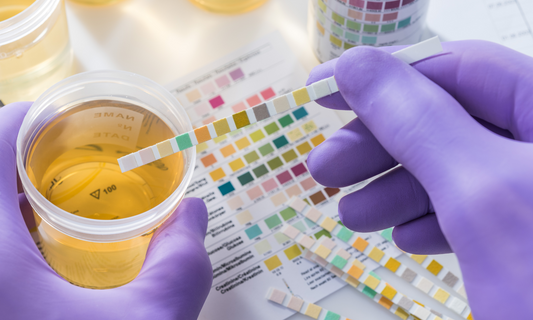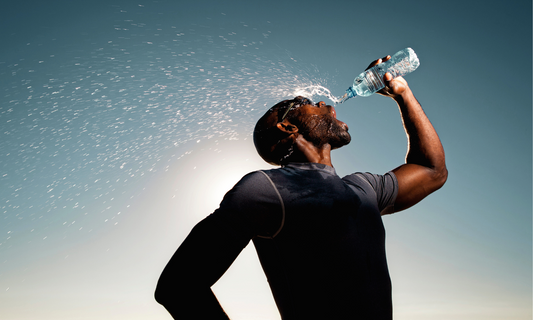Dehydration in children: what are our tips?

A child can become dehydrated quickly, especially during illness or in extreme heat . This is a dangerous phenomenon because dehydration unfortunately remains a major cause of infant mortality.
Additionally, infants have very high water needs relative to their body weight and may have difficulty expressing or satisfying their thirst on their own. By the way, did you know that 80% of an infant's weight is water? As a reminder, in adults, this represents approximately 60%!
Recognizing the signs and knowing how to react is crucial to preventing serious complications. This article will help you understand the causes, symptoms, diagnosis, and treatment of dehydration in children, based on their age.
Causes of dehydration in children

The causes of dehydration in children are numerous and are not limited to periods of extreme heat. Therefore, it is always important to pay attention to the condition of children. To do this, it is recommended to pay attention to the most common and identifiable causes, which are:
Diarrhea
Diarrhea is underestimated because it is often viral, short-lived, and benign. However, it systematically causes significant water loss that can directly lead to severe dehydration, especially in infants.
This is even more the case for acute diarrhea, associated with continuous, liquid stools, which will lead to an even greater loss of mass and water.
For all diarrhea, it will be necessary to replace lost water and mineral salts to avoid complications or even hospitalization.
Vomiting
Vomiting is also dangerous for a child's health. Repeated vomiting can cause significant fluid loss, leading to dehydration, which will require supplementation with minerals, vitamins, and nutrients.
- Childhood fever
In babies and young children, a fever is often a cause for concern. An infection has likely set in, and the fever is fighting it. If your child has a temperature above 39°C and it lasts for more than two days, they may eat less, drink less, and sweat profusely . This can increase the risk of dehydration.
- Infant gastroenteritis
Gastroenteritis combines the symptoms of diarrhea , vomiting and fever , and it must be taken very seriously, especially in a very young child, whose body is composed 80% water. Body water loss is more pronounced and dehydration is a real danger for the child.
- The heat
During heat waves and extreme heat , prolonged exposure to the sun, spending too much time in a poorly ventilated room and low water consumption can lead to dehydration in children: they sweat and lose fluid. Here too, they must be rehydrated without delay.
Signs and symptoms of dehydration in children
To combat dehydration, it's first important to identify it correctly and effectively. There are many symptoms that can potentially indicate dehydration or its onset.
Symptoms in infants

Infant dehydration presents specific signs. Since infants are obviously unable to identify and express their own needs, it is important to pay close attention to them. Here are the symptoms in infants:
-
A dry mouth and lack of saliva: the appearance of the lips can help identify it.
-
Less wet diapers or the need to change fewer than 4 diapers per day.
-
The fontanelle (soft area on the head) is abnormally sunken.
-
The appearance of crying without tears.
-
Unusual sleepiness or irritability.
Symptoms in older children (2-7 years)
The signs evolve as the child grows. Even if they can express their thirst or symptoms more easily, you should still remain attentive to these signs:
-
An intense thirst testified by the child,
-
Very dark and infrequent urine,
-
Dizziness and fatigue,
-
Dry, dark-circled or sunken eyes,
-
Abnormal confusion and irritability,
-
Sticky or dry oral mucous membranes (tongue, lips),
-
A sudden weight loss. In children, dehydration can occur with a 3% weight loss, rising to 5% for severe dehydration . Beyond 10%, vital organs are at great risk.
Stages of dehydration in children
It is important to know that dehydration in children is divided into several stages with visible progression of symptoms. It is therefore important to effectively identify the signs in order to prevent it from progressing to the next stage. These stages can be identified by the following symptoms:
- Mild dehydration
-
Appearance of thirst
-
Onset of dry mouth
-
Visible decrease in the amount of urine
- Moderate dehydration
-
Dryness and cooling of the skin
-
Increased fatigue and drowsiness
-
Urine that becomes darker
- Severe dehydration
-
Complete absence of urination (the act of urinating)
-
Lethargy and disturbances of consciousness
-
Possibly vomiting and convulsions
Diagnosis of dehydration in children
After the first identifiable signs appear, it is important to properly diagnose the child. Several methods can then be implemented:
- The physical examination
To diagnose dehydration physically, one can observe the elasticity of the skin, which may be reduced. As mentioned earlier, the deeper set eyes and the sunken fontanelle in infants are also notable.
- Analysis of vital functions
Assessing vital signs is also an important step in diagnosis. Heart rate may increase during exercise to pump blood that becomes more viscous due to lack of water. Blood pressure may also be affected because dehydration affects the body's ability to manage blood pressure.
- Carrying out tests
Finally, additional tests can be carried out to confirm and clarify dehydration, such as blood tests to assess electrolyte levels and urine analysis to check their concentration and color.
Treatment of dehydration in children
When the first signs of mild dehydration appear, don't panic, but rather address the problem quickly. There are several ways to rehydrate yourself, other than simply drinking water.
These different methods depend on the severity of dehydration and the age of the child . They allow for the treatment of associated problems such as electrolyte loss.
Treatment in infants
To rehydrate an infant , oral rehydration solutions (ORS) containing electrolytes, sugar, and zinc can be given orally. It is most effective to give small, frequent doses, about 5 to 10 ml every 5 minutes.
In the most severe cases, or when dehydration causes vomiting (preventing effective oral rehydration), rehydration by infusion may be necessary.
Treatment in older children
Oral rehydration solutions (ORS) can also be used to rehydrate children. Even if children refuse to drink a lot at once, they can still be encouraged to take small sips frequently.
After rehydration, it is recommended to resume a light, electrolyte-rich diet , such as bananas, rice, or soups.
Prevention of dehydration in children
Even though you've seen how to easily identify the signs of dehydration in children and how to treat them, it's still best to prevent the problem by staying properly hydrated.
The best way to do this is to directly monitor children's hydration, especially during periods of illness or extreme heat. If they don't usually drink a lot of water, it's still possible to offer them something to drink regularly, even when they're not thirsty.
For more active children and outdoor activities, it is very effective to use electrolyte-enriched drinks. For this, you can use Hydratis lozenges , which contain electrolytes and trace elements, optimizing the absorption of water in the body. In this way, it will significantly reduce the risk of dehydration. We offer different flavors to suit everyone! Please note that we recommend consulting a healthcare professional for children aged 3 and 4, and for older children (4 to 10 years), we recommend a maximum of 3 lozenges per day to improve their hydration.

What should you remember about dehydration in children?
Dehydration in children is an emergency that should not be taken lightly. By recognizing the signs early and providing adequate rehydration, parents can avoid serious complications. Don't hesitate to consult a healthcare professional if you have any concerns about your child's hydration status.
Bibliography
Montain, S., & Coyle, E. (1992). Influence of graded dehydration on hyperthermia and cardiovascular drift during exercise.. Journal of applied physiology, 73 4, 1340-50. https://doi.org/10.1152/JAPPL.1992.73.4.1340 .
Gradual dehydration during exercise increases core temperature, heart rate, and stroke volume, with larger volumes of fluid reducing these effects: https://www.inspq.qc.ca/mieux-vivre/sante/problemes-sante-courants/deshydration?











